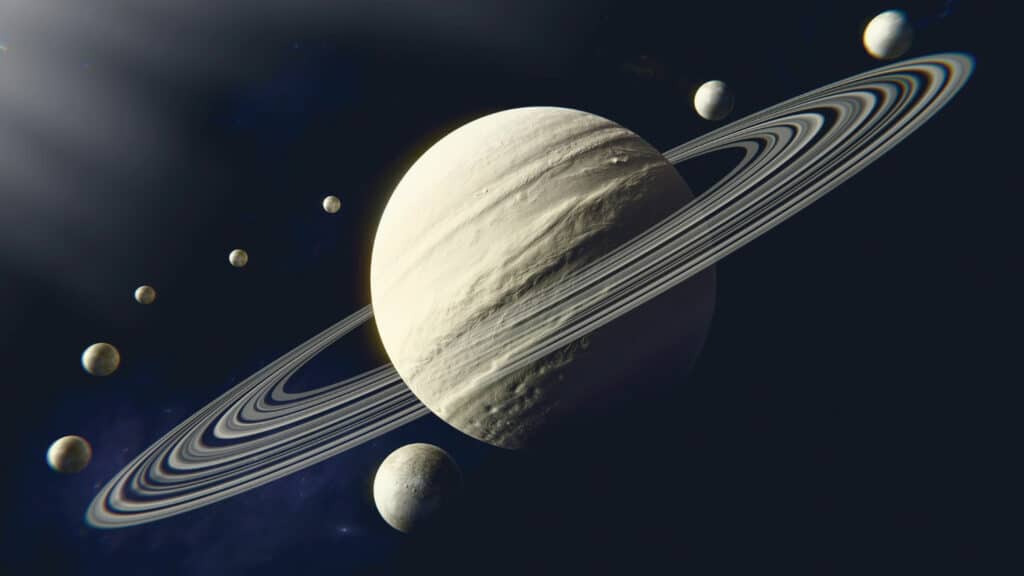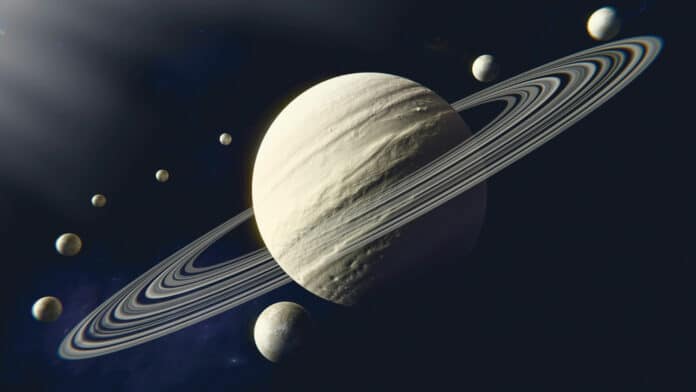Using a technique called ‘shift and stack’, an international team of astronomers has discovered 62 new moons of Saturn. This discovery gives Saturn its rank back to the first position in planets with the most number of moons. There is now a total of 145 recognized (by the International Astronomical Union) moons orbiting Saturn.
New discoveries have made numerous achievements for the ringed planet possible. In addition to reclaiming the title of the planet with the most known moons (outperforming Jupiter with 95 recognized moons), Saturn is the first planet to have more than 100 total moons found.
Saturn’s surroundings have been routinely studied for moons with increasing sensitivity over the past two decades. In this study, the team used the ‘shift and stack’ technique, which is usually used to find moons around Neptune and Uranus.
The moon’s signal is enhanced when all the data is merged as a result of shifting a set of sequential images at the pace that the moon is moving across the sky. This enables moons that were too faint to be detected in individual images to become visible in the stacked image.
The scientists made use of data collected between 2019 and 2021 by the Canada-France-Hawaii Telescope (CFHT) atop Mauna Kea in Hawaii. They found moons of Saturn with diameters as little as 2.5 km by moving and stacking a large number of sequential images collected over three-hour periods.
The original discovery search was done in 2019. Scientists uncovered the moons in a meticulous search of the deep CFHT imaging acquired that year.

However, simply spotting an object in the sky near Saturn does not prove that it is a moon; in theory, it could also be an asteroid that just so happened to be passing by the planet (although this is doubtful). The object must be monitored for several years before it can be positively determined that it is orbiting the planet. The team has successfully tracked 63 objects, confirming them to be new moons, after methodically comparing objects discovered on various nights over two years.
One of the new moons, S/2019 S 1, was announced in 2021, with the rest being announced over the last couple of weeks. Some of the team’s linked orbits were identified with past observations from many years ago that briefly glimpsed some of these moons.
Edward Ashton (currently a postdoctoral fellow at Taiwan’s Academia Sinica Institute of Astronomy and Astrophysics) said, “Tracking these moons makes me recall playing the kid’s game Dot-to-Dot because we have to connect the various appearances of these moons in our data with a viable orbit but with about 100 different games on the same page and you don’t know which dot belongs to which puzzle.”
All new moons belong to the category of irregular moons, which are considered to have been captured by their home planet at some point in the past. In contrast to normal moons, irregular moons have larger, elliptical, and tilted orbits. With 58 already known before the search started, the number of known Saturnian irregular moons has more than doubled to 121. There are 145 recognized moons orbiting Saturn, including the 24 normal moons, according to the International Astronomical Union.
The tilt of the orbits of the irregular moons causes them to cluster into orbital groupings. There are three such groupings in the Saturnian system, whose names are taken from various mythologies: the Inuit group, the Gallic group, and the Norse group. Three recent discoveries, S/2019 S 1, S/2020 S 1, and S/2005 S 4, for instance, are part of the Inuit group and have very tiny orbits that are slanted similarly to the larger irregulars Kiviuq and Ijiraq, which were previously recognized.
All new moons belong to one of the three categories, with the Norse group once more having the greatest number of members.
